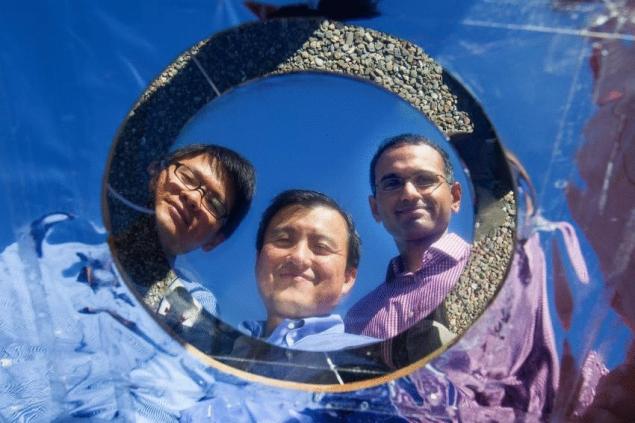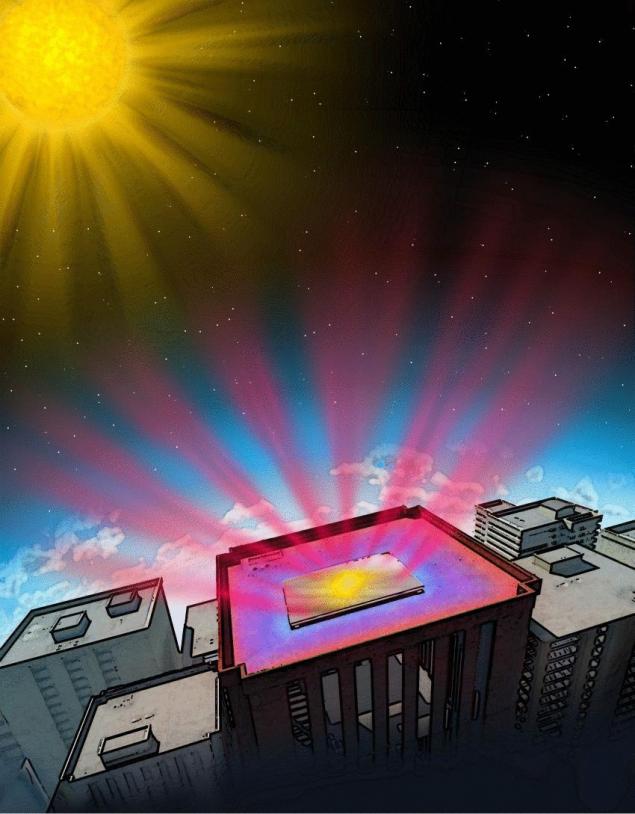622
Why to reflect heat back into space

Not long ago Stanford engineers have invented revolutionary coating material that can help cool buildings even in Sunny days, reflecting the warmth from them and sending them directly into space. The team led by electrical engineering Professor Shanhui Fan and researcher of Aswata Ramana published results in the journal Nature. Will the engineers the Nobel prize for his work? Why do we need it?
How does it work?The basis of the invention on ultra-thin multilayered material that interacts with light, both visible, and invisible, a whole new way.
Invisible light in the form of infrared radiation is a form of heat emitted by all objects and living beings. When we stand in front of a closed oven and not touch her, the heat that we feel is infrared light. This invisible light and the scientists of Stanford to send back to space.
Of course, the sunlight seriously heats the building. New material, interacting with the radiation, will act as a stunningly efficient mirror that reflects virtually all the incoming sunlight.
Based on the so-called photonic radiative cooling — which will not only relieve the infrared heat inside the building, but also to reflect the sunlight. The result can appear cooling buildings that do not require air-conditioning.
"This is a very new and extremely simple idea, said Eli, Yablonovich, Professor of engineering at the University of California at Berkeley and a pioneer of Photonics who directs the Center for energy efficient electronics science. — Thanks to the work of Professor Fan, we will be able to use radiation cooling not only at night but in the daytime, which is quite surprising".
The researchers say they designed the material that will be cost-effective for large-scale deployment on the roof of a building under construction. Although this technology is still very young, one day it could lead to a significant reduction in demand for electricity. The air conditioning system in the U.S. alone accounts for about 15% of the energy used.
In practice, according to the researchers, this coating can be sprayed on a more solid material.
"The team has shown how to passively cool buildings, just sending heat into the cold darkness of space," said Nobel prize-winning physicist Burton Richter, Professor Emeritus of Stanford and former Director of the research center, which is now called "SLAC national accelerator laboratory".
The warming world needs cooling technologies that don't require power, according to Raman, lead author of the work. "In developing countries, photonic radiative cooling can provide cooling without the need for power supply in rural areas, and seriously reduce the need for air conditioning in urban skyscrapers."
Window космос

Heat can be transferred three ways: conduction, convection, and radiation. The conductivity is provided by the contact. So we don't touch hot pans with my bare hands. Convection transfers heat through movement of liquid or air. You know it by the warm current of air from an open oven. Radiation (radiation) transfers heat in the form of infrared radiation that emanates from objects, but is invisible.
The first part of the surface of the innovative material emits infrared light directly into space. The ultrathin coating was carefully designed to send infrared light away from buildings at exactly the specified frequency, which will allow it to pass through the atmosphere without warming the air. This key feature is taken into account due to global warming.
"Think about it, if we have a window into space," says Fan.
However, just send the heat into space is not enough. Multilayer coating acts as a highly efficient mirror, absorbing 97% of the sunlight falling on the building and heating it.
"We created something like an SLR battery," says Raman.
Emission and reflection together allow the photonic radiative cooling material can stay at 9 degrees colder than the surrounding air during the day. Multilayer material has a thickness of 1.8 microns, is thinner than aluminum foil.
It consists of seven layers of silicon dioxide and hafnium oxide is deposited over the thin layer of silver. These layers have the same thickness. The internal structure of a material to radiate infrared rays at a frequency that lets them pass into space without heating the air and buildings.
"This photonic approach allowed us to fine-tune the reflection of sunlight and infrared heat radiation," says Lingcao Zhu, co-author of the article. Indeed, the material developed using the best practices of nanophotonics.
From prototype to stroitelstvoimoti photonic radiative cooling on a large scale requires the solution of two remaining technical problems.
First, you need to decide how to conduct the heat inside the building to outside the coating. Once there, the heat is sent directly into space, but engineers need to figure out how to efficiently transfer heat buildings on the surface.
Secondly, the problem remains the production. Now a team of Stanford has a prototype the size of a pizza. But cooling buildings will require large panels. The researchers say that they need large manufacturing capacity to make panels of the desired sizes.
In a broader sense, the team believes that their project is the first step toward using the cold of space as a resource. Just as sunlight is a renewable energy source the sun, the coldness of the universe can provide unlimited possibilities for cooling. In other words, the speed of light equal to speed of darkness.
"Every object that produces heat has to drain it in the heat sink tells the Fan. We paved the way to the study of how to use the coldness of the universe as a heat sink during the day."
Source: hi-news.ru
Anti-aging cream from the inventor of the artificial pancreas Chris Toumazou
In France there was a tree that produced electricity























